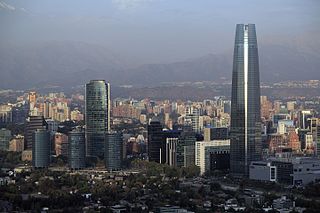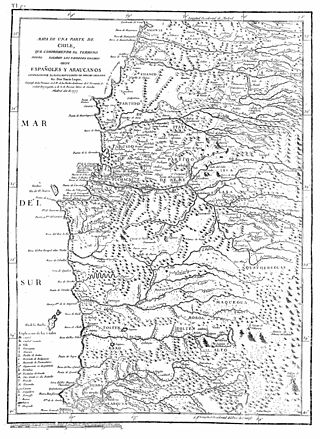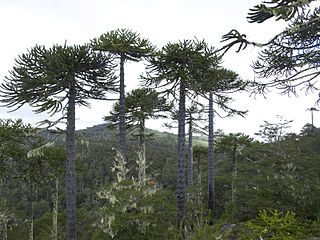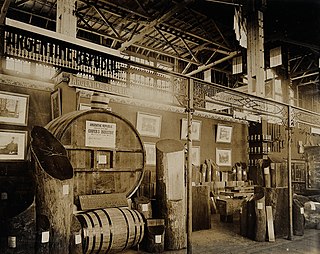
The economy of Chile is a market economy and high-income economy as ranked by the World Bank. The country is considered one of South America's most prosperous nations, leading the region in competitiveness, income per capita, globalization, economic freedom, and low perception of corruption. Although Chile has high economic inequality, as measured by the Gini index, it is close to the regional mean.

The Mapuche are a group of indigenous inhabitants of south-central Chile and southwestern Argentina, including parts of Patagonia. The collective term refers to a wide-ranging ethnicity composed of various groups who shared a common social, religious, and economic structure, as well as a common linguistic heritage as Mapudungun speakers. Their homelands once extended from Aconcagua Valley to Chiloé Archipelago and later spread eastward to Puelmapu, a land comprising part of the Argentine pampa and Patagonia. Today the collective group makes up over 80% of the indigenous peoples in Chile, and about 9% of the total Chilean population. The Mapuche are concentrated in the Araucanía region. Many have migrated from rural areas to the cities of Santiago and Buenos Aires for economic opportunities.

The Biobío Region is one of Chile's sixteen regions. With a population of 1.5 million, thus being the third most populated region in Chile, it is divided into three provinces: Arauco, Biobío and Concepción. The latter contains its capital and largest city, Concepción, a major city and metro area in the country. Los Ángeles, capital of the Biobío Province, is another important city in the region.

Cañete is a city and commune in Chile, located in the Arauco Province of the Biobío Region. It is located 135 km to the south of Concepción. Cañete is known as a "Historic City" as it is one of the oldest cities in the country. The Battle of Tucapel and Pedro de Valdivia's death happened near the city's current location. Cañete was also an important location in the Arauco War.

The Arauco War was a long-running conflict between colonial Spaniards and the Mapuche people, mostly fought in the Araucanía. The conflict began at first as a reaction to the Spanish conquerors attempting to establish cities and force Mapuches into servitude. It subsequently evolved over time into phases comprising drawn-out sieges, slave-hunting expeditions, pillaging raids, punitive expeditions, and renewed Spanish attempts to secure lost territories. Abduction of women and war rape was common on both sides.

The Nahuelbuta Range or Cordillera de Nahuelbuta is a mountain range in Bio-Bio and Araucania Region, southern Chile. It is located along the Pacific coast and forms part of the larger Chilean Coast Range. The name of the range derives from the Mapudungun words nahuel (jaguar) and futa (big).

Pedro de Oña (1570–1643) is considered the first known poet born in Chile, and is best remembered for his verse epic poem Primera parte de Arauco domado. Born in Angol, he was the son of a military captain, Gregorio de Oña, who had perished during the conquest of Chile by Spain. Pedro de Oña grew up amid this ongoing conflict; he was born in what was then a small military post, in a territory largely controlled by Chile's indigenous peoples.

Lebu is a port city and commune in central Chile administered by the Municipality of Lebu. Lebu is also the capital of Arauco Province in Bío Bío Region. It lies on the south bank of the mouth of the Lebu River.

Agriculture in Chile encompasses a wide range of different activities due to its particular geography, climate, geology and human factors. Historically agriculture is one of the bases of Chile's economy, now agriculture and allied sectors—like forestry, logging and fishing—account only for 4.9% of the GDP as of 2007 and employed 13.6% of the country's labor force. Some major agricultural products of Chile include grapes, apples, onions, wheat, corn, oats, peaches, garlic, asparagus, beans, beef, poultry, wool, fish and timber. Due to its geographical isolation and strict customs policies, Chile is free from diseases such as Mad Cow, fruit fly and Phylloxera, this plus being located in the southern hemisphere and its wide range of agriculture conditions are considered Chile's main comparative advantages. However, the mountainous landscape of Chile limits the extent and intensity of agriculture so that arable land corresponds only to 2.62% of the total territory.

The forestry sector in Argentina has great potential. The geography of the country extends from north to south, encompassing 4,000 kilometres (2,500 mi). Its variety of climates, land quality, and reliable precipitation allow for the cultivation of different tree species at high growth rates. The climate varies and most areas are quite temperate. The country also enjoys short harvest periods for the most important species. This has allowed the industry to become more competitive and continue its high growth rates.

Coordinadora Arauco-Malleco (CAM) is a radical, militant indigenous organization engaged in political violence in pursuit of attaining an autonomous Mapuche state in the territory they describe as Wallmapu.
The Mapuche conflict involves indigenous Mapuche communities, also known as the Araucanians, located in Araucanía and nearby regions of Chile and Argentina. It is often referred to as a conflict between the Mapuche and the Chilean government or state, despite the fact that there have been a variety of other actors participating in the conflict such as the Spanish Empire as well as corporations such as big forestry companies and their contractors. In the past decade of the conflict, Chilean police and some non-indigenous landowners have been confronted by militant Mapuche organizations and local Mapuche communities in the context of the conflict. Some scholars argue the conflict is an indigenous self-determination conflict, others like Francisco Huenchumilla see it as the expression of a wider political conflict that affects all of Chile given the existence of other indigenous groups.

In Chilean historiography, Colonial Chile is the period from 1600 to 1810, beginning with the Destruction of the Seven Cities and ending with the onset of the Chilean War of Independence. During this time, the Chilean heartland was ruled by Captaincy General of Chile. The period was characterized by a lengthy conflict between Spaniards and native Mapuches known as the Arauco War. Colonial society was divided in distinct groups including Peninsulars, Criollos, Mestizos, Indians and Black people.
As an archaeological culture, the Mapuche people of southern Chile and Argentina have a long history which dates back to 600–500 BC. The Mapuche society underwent great transformations after Spanish contact in the mid–16th century. These changes included the adoption of Old World crops and animals and the onset of a rich Spanish–Mapuche trade in La Frontera and Valdivia. Despite these contacts Mapuche were never completely subjugated by the Spanish Empire. Between the 18th and 19th century Mapuche culture and people spread eastwards into the Pampas and the Patagonian plains. This vast new territory allowed Mapuche groups to control a substantial part of the salt and cattle trade in the Southern Cone.
The origin of the Mapuche has been a matter of research for over a century. The genetics of the Mapuche do not show overly clear affinities with any other known indigenous group in the Americas, and the same goes for linguistics, where the Mapuche language is considered a language isolate. Archaeological evidence shows Mapuche culture has existed in Chile at least since 600 to 500 BC. Mapuches are late arrivals in their southernmost and easternmost (Pampas) areas of settlement, yet Mapuche history in the north towards Atacama Desert may be older than historic settlement suggest. The Mapuche has received significant influence from Pre-Incan (Tiwanaku?), Incan and Spanish peoples, but deep origins of the Mapuche predates these contacts. Contact and conflict with the Spanish Empire are thought by scholars such as Tom Dillehay and José Bengoa to have had a profound impact on the shaping of the Mapuche ethnicity.

Agriculture in Chile has a long history dating back to the Pre-Hispanic period. Indigenous peoples practised varying types of agriculture, from the oases of the Atacama Desert to as far south as the Guaitecas Archipelago. Potato was the staple food in the populous Mapuche lands. Llama and chilihueque herding was practised by various indigenous groups.
[Chile] is rich in pastures and cultivated fields, in which all kind of animals and plants can be breed or grown, there is plenty of very beautiful wood for making houses, and plenty of firewood, and rich gold mines, and all land is full of them...

Camilo Marcelo Catrillanca Marín was a Mapuche farmer from Temucuicui in Chile who was shot to death by the Chilean police force under suspicious circumstances. The incident led to protests against police violence, and occurred in the broader context of the ongoing conflict over Mapuche civil rights.
Temucuicui or Temocuicui is a locality made up a group of Mapuche communities in the commune of Ercilla, Malleco Province, Araucanía Region, in Chile.

Among the indigenous Mapuche people of Chile, there is those that practise traditional polygamy. In modern Chile polygamy has no legal recognition. This puts women whose marriages to their husbands are not legally recognized at a disadvantage to the legal wife who is in terms of securing inheritance. Polygamy is much less common today, particularly in comparison with the time preceding the Occupation of Araucanía (1861–1883), when the traditional Mapuche homeland was finally brought under control of the Chilean government. It survives as a chiefly rural practice, but has also been reported in the low-income peripheral communities of Santiago. Wives who share the same husband are often relatives, such as sisters, who live in the same community. According to folklore, polyandry among the Mapuche is reputed to exist at least historically, in which case the husbands may have been brothers, but no documentation exists attesting to this phenomenon. It is also in contradiction to the renewal of the warrior ethos (weichan) promoted by militant organizations such as Coordinadora Arauco-Malleco.
Forestal Mininco is the forestry branch of wood product and woodpulp company CMPC. According to CMPC "Forestal Mininco territorially manages the forest heritage of CMPC in Chile."

















